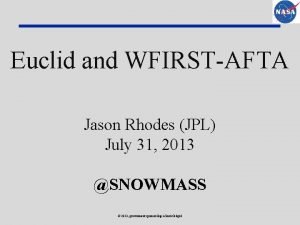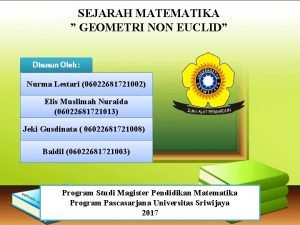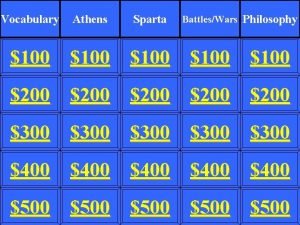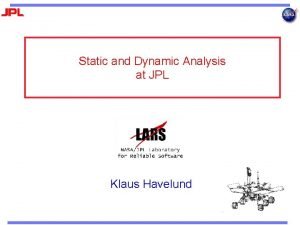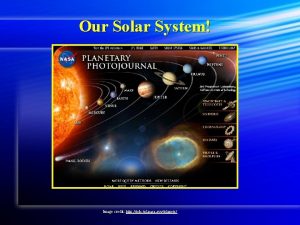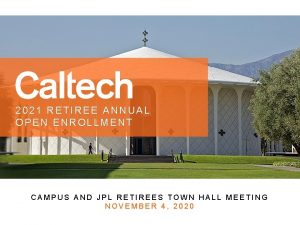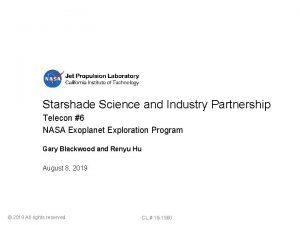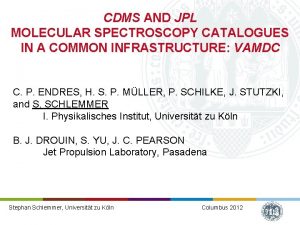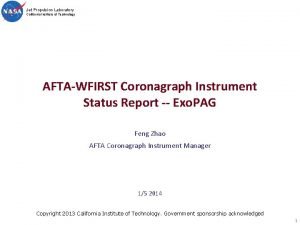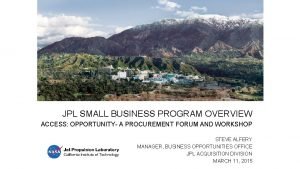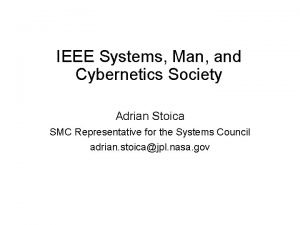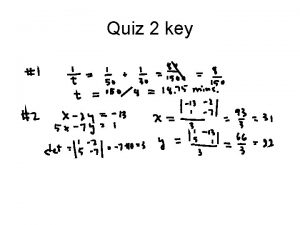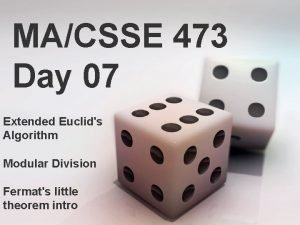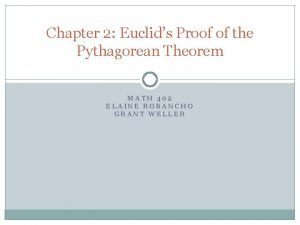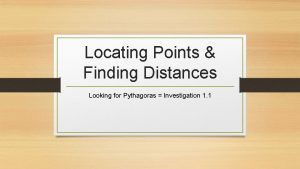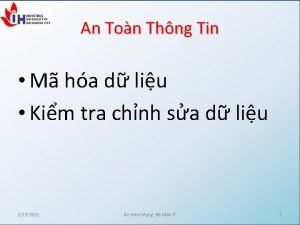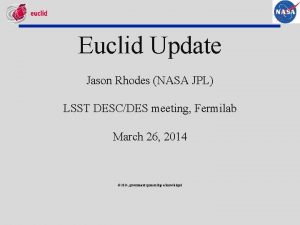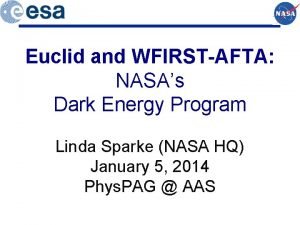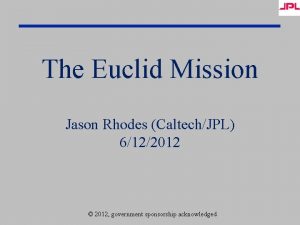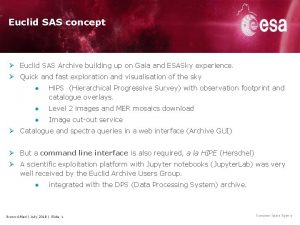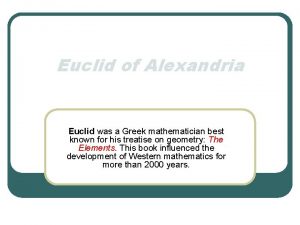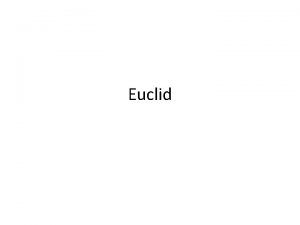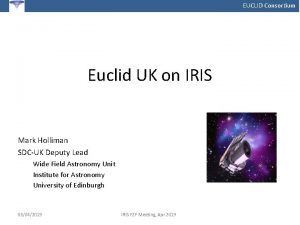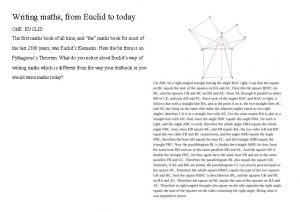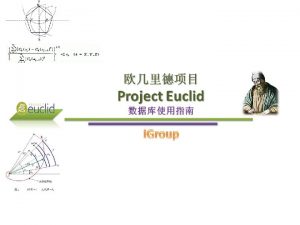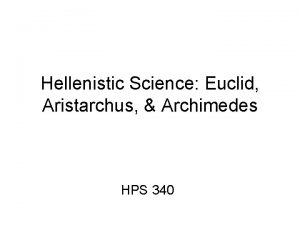Euclid and WFIRSTAFTA Jason Rhodes JPL July 31















- Slides: 15

Euclid and WFIRST-AFTA Jason Rhodes (JPL) July 31, 2013 @SNOWMASS © 2013, government sponsorship acknowledged

Euclid: Mapping the geometry of the Dark Universe 2004: Dark Universe Mission proposed as a Theme to ESA’s Cosmic Vision programme Oct 2007: DUNE and SPACE jointly selected for an ESA Assessment Phase April 2010: Formation of single Euclid Consortium 2010 -2011: Definition phase July 2011: Final Euclid Proposal- Red Book Oct 2011: Cosmic Vision Approval of Euclid Fall 2012: NASA Joins, selects 40 US participants for funding 2012 -2020: Implementation phase (1200+ member consortium) 2020: launch 2020 -2026 : science operations

Euclid goals Understand the nature of Dark Energy and Dark Matter by: • Measuring the DE equation of state parameters w 0 and wa to a precision of 2% and 10%, respectively, using both expansion history and structure growth. • Measuring the growth factor exponent γ with a precision of 2%, enabling to distinguish General Relativity from the modified-gravity theories • Testing the Cold Dark Matter paradigm for structure formation, and measure the sum of the neutrino masses to a precision better than 0. 04 e. V when combined with Planck. • Improving by a factor of 20 the determination of the initial condition parameters compared to Planck alone. Responsive to some of the scientific goals outlined in NWNH Panel Reports: • How did the universe begin? • Why is the universe accelerating? • What is dark matter? • What are the properties of neutrinos?

Euclid concept • Optimized for two complementary cosmological probes: —Weak Gravitational Lensing —Galaxy Clustering (Baryonic Acoustic Oscillations & Redshift Space Distortions) Additional probes: clusters, ISW 15, 000 square degree survey —Imaging (WL): • High precision visible imaging at (shapes) • NIR Photometry (photo-z) —Near Infrared Spectroscopy (Galaxy Clustering) —Not optimized for SN

Euclid Mission Baseline Mission elements: • L 2 Orbit • 6. 25 yr primary mission • Telescope: three mirror astigmat (TMA) with 1. 2 m primary • Instruments: – VIS: Visible imaging channel: 0. 5 deg 2, 0. 10’’ pixels, 0. 16’’ PSF FWHM, very broad band r+i+z (0. 5 -0. 9 mu), 36 CCD detectors, galaxy shapes – NISP: NIR channel: 0. 5 deg 2, – 16 Hg. Cd. Te detectors, 1 -2 mu: • Photometry: 0. 3’’ pixels, 3 bands Y, J, H, photo-z’s • Spectroscopy: slitless, R=500, redshifts From NASA

Euclid Mission in 6. 25 yrs 15, 000 deg 2 40 deg 2 Shapes + Photo-z of n = 1. 5 x 109 galaxies ? z of n=5 x 107 galaxies Ref: Euclid RB ar. Xiv: 1110. 3193 ~2 billion shapes and 50 million spectra

Euclid Data Release • Q 2 2020 Launch • “Quick release” data releases at 14, 38, 62, 74 months • Not suitable for cosmology (small area) • Full releases at: • 26 months (2600 sq deg) • 50 months (7500 sq deg, cumulative) • 74 months (15000 square degrees cumulative)

Euclid Science Reach From Euclid Red Book : sci. esa. int/science-e/www/object/index. cfm? fobjectid=48983

WFIRST - AFTA Wide Field Infrared Survey Telescope. Astrophysics Focused Telescope Asset • • Might see this called AFTA in the future AFTA is the version of WFIRST that uses a 2. 4 m telescope This asset comes from the NRO Offers a fundamentally new regime of DE (and other) research A wide field HST

AFTA will deliver extraordinary science A 2. 4 m telescope offers sensitive sharp images at optical and near IR wavelengths across a wide field. With higher resolution and sensitivity in the near IR than planned for the early WFIRST designs, AFTA will be an even more powerful and compelling mission. AFTA offers both a rich program of community observations and directed programs that address fundamental astronomy questions: • What is dark energy? • Is our solar system special? • Are the planets around nearby stars like those of our own solar system? • How do galaxies form and evolve? AFTA is low risk and low cost - Cost similar to DRM 1 & Astro 2010 WFIRST - Existing telescope lowers risk - 2021 launch feasible if budget is available 10

AFTA Instruments Wide-Field Instrument - Imaging & spectroscopy over 1000 s sq deg. - Monitoring of SN and microlensing fields - 0. 7 – 2. 0 micron bandpass - 0. 28 sq deg Fo. V (100 x JWST Fo. V) - 18 H 4 RG detectors (288 Mpixels) - 4 filter imaging, grism + IFU spectroscopy Coronagraph (study option) - Imaging of ice & gas giant exoplanets - Imaging of debris disks - 400 – 1000 nm bandpass - 10 -9 contrast - 100 milliarcsec inner working angle at 400 nm Requires focused tech. development ASAP for 2021 launch


Summary: Extragalactic Surveys WFIRST DRM 1 From Chris Hirata WFIRST DRM 2 Big Telescope Implementation 1. 3 m unobs 36 H 2 RG 0. 18”/p 1. 1 m unobs 14 H 4 RG 0. 18”/p 2. 4 m obs 20 H 4 RG 0. 0975”/p Imaging Survey* [4 filters for all; depths are 5σ isolated pt src] 0. 92— 2. 40 μm 26. 0— 26. 2 mag AB 2800 deg 2/yr EE 50 = 0. 15— 0. 21” 0. 92— 2. 40 μm 25. 8— 26. 0 mag AB 2900 deg 2/yr EE 50 = 0. 18— 0. 25” 0. 92— 2. 17 μm 26. 9— 27. 3 mag AB 1080 deg 2/yr EE 50 = 0. 11— 0. 14” Weak Lensing [reddest 3 filters] 30, 33, 32 gal/am 2 24, 26, 25 gal/am 2 79, 82, 72 gal/am 2 Redshift Survey [≥ 7σ Hα detections] z = 1. 28— 2. 66 4900 gal/deg 2 2900 deg 2/yr z = 1. 59— 2. 66 2900 gal/deg 2 4400 deg 2/yr z = 1. 13 – 2. 20 4900 gal/deg 2 4000 deg 2/yr * The big telescope could in principle support an accelerated imaging mode matching the WFIRST DRM 1 survey rate of 2800 deg 2/yr. This reaches depth of 25. 8— 26. 0 mag AB and 26/31/32 galaxies per arcmin 2. This survey is heavily read noise limited (90 s exposures) so may not be the best use of a big telescope.

WL: A completely different regime • • WL with AFTA survey would reach >80 galaxies per square arcminute — vs ~30 w/Euclid, and even fewer from the ground With a deeper survey AFTA could reach HUDF depths of >300 galaxies per square arcminute This is a fundamentally different WL regime that is not possible from the ground or with a 1. 3 meter class telescope due to PSF size. • • • Does not necessarily help with DE Fo. M (wide>deeper for Fo. M) Much better calibration data Much better for understanding dark matter

Detector Layout on Sky 18 NIR detectors 0. 11 arcsec/pixel 0. 28 deg 2 Each square is a H 4 RG-10 4 k x 4 k, 10 micron pitch 288 Mpixels total Slitless spectroscopy with grism in filter wheel R_q ~ 100 arcsec/micron 15
 Jason rhodes md
Jason rhodes md Geometri non euclid
Geometri non euclid Pythagoras and euclid were outstanding hellenistic
Pythagoras and euclid were outstanding hellenistic Jpl c coding standard
Jpl c coding standard Http://pds.jpl.nasa.gov/planets/
Http://pds.jpl.nasa.gov/planets/ Caltech retiree benefits
Caltech retiree benefits Gary blackwood jpl
Gary blackwood jpl Jpl molecular spectroscopy
Jpl molecular spectroscopy Jpl org chart
Jpl org chart Jpl siri
Jpl siri Adrian stoica jpl
Adrian stoica jpl Euclidean algorithm example
Euclidean algorithm example Euclid's algorithm
Euclid's algorithm Euclid's theorem
Euclid's theorem Looking for pythagoras
Looking for pythagoras Thuật toán euclid mở rộng
Thuật toán euclid mở rộng
